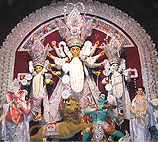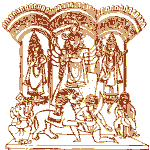 |
| a home away from home |
| HOME FEEDBACK TELL A FRIEND WEB SITE DESIGN CAREER WITH US CONTACT US |
|
|
Among
the commonly seen chali is the Markini Chal. This is a semicircle
stretching from one end of the idol to the other supported by two
pillars. |
| Markini Chal |
Mothchouri
chal has three continuous semicircular divisions like a wave with
three peaks. |
|
| Mothchouri Chal |
|
|
For a Shakta (worshipper of mother goddess) family the tiger would retain its original form, while for a Baishnava family the same lion would look like a white horse, a form of the Narasimha Avatar of Vishnu. Blue is used as a base with a few exceptions of pink ones. The figures are generally painted in reds. Other colours used are yellow, green, pink and black. In some occasions the chali used to be divided with dark margins like "Choukopots" having images like Narada, Narayana, Shiva, Indra Brahma. In some other region the figures are found to be floting. But in all cases only the profile of the figures are shown. |
 |
|
Lack of patronage has brought a decline to this lively art. Besides as the challis are generally immersed with the idols no legacy is found. Present day artists are inferior in talent as they have lack of in depth knowledge of Puranas. Besides a few Royal houses of Bengal and a few traditional houses and museums there is always unawareness for its preservation among common people. Nowadays Chalchira is used as a part of decoration with a few common decorative motives. |
|
GREAT INDIANS || BENGALI SECTION || BENGALI MARRIAGE || BABY'S NAME || WALLPAPER || BENGAL || WEATHER || TRAVEL
MOBILE WALLPAPER || E-CARD || MOVIE || WEBSITE LINKS || ASSOCIATIONS || SHOPPING || ASTROLOGY || MUSIC || BEAUTY CARE
TIGER || NEWS || GUEST CORNER || FEEDBACK || LINK TO US || FOR ADVERTISING || SERVICES || CONTACT || BENGALI CALENDAR
Graphics, Sound or content copied or produced in part or whole in any media will be illegal.
Persons or websites caught using our material will be penalized.
Privacy Statement || Copyright
Copyright ©1999-2014 BANGALINET.COM

